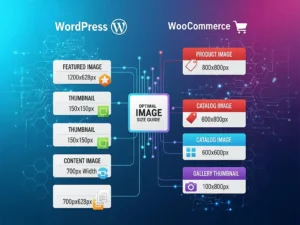What is e-commerce?
E-commerce, short for electronic commerce, is a type of business that consists of buying and selling products and services over the Internet. This model of commerce allows transactions to be carried out virtually, without the need for physical interaction between buyer and seller.
In e-commerce, transactions are carried out on online platforms such as websites, mobile applications, or digital marketplaces. Consumers can browse products, select the items they want, make the payment, and finalise the purchase, all via Internet-connected devices such as computers, smartphones, or tablets.
This form of commerce has become increasingly important in recent years, driven by advances in technology and changes in society’s consumer habits. More and more people are choosing to shop online because of the convenience, variety of products available and ease of comparing prices.
E-commerce encompasses a wide variety of transactions, from selling physical products such as electronics, clothes, and food to offering digital services such as streaming video, music, or software. It can also take place between companies (B2B), between companies and consumers (B2C), between consumers (C2C) or from the consumer to the company (C2B).
This business model offers several advantages for both consumers and merchants, including convenience, global accessibility, a wide range of available products and reduced costs. However, it also presents challenges, such as security issues, fierce competition, and complex logistics.
In addition to traditional forms of e-commerce, such as online shops and marketplaces, there are other modalities that also fit this definition. Affiliate business is one example, as are sales via social networks.
In short, e-commerce represents a revolution in the world of commerce, offering new business opportunities and changing the way people buy and sell products and services. It’s a trend that’s here to stay and will continue to shape the future of global commerce.
Types of e-commerce
B2B (Business-to-Business)
B2B e-commerce refers to commercial transactions carried out between companies. In this model, companies buy and sell products or services to each other. For example, a manufacturer of electronic components might sell its products to a smartphone manufacturing company. B2B e-commerce is often used in industries where products are sold in bulk or in large quantities.
B2C (Business-to-Consumer)
B2C e-commerce involves commercial transactions between companies and individual consumers. In this model, companies sell products directly to consumers via websites, mobile applications, or online marketplaces. It is the most common type of e-commerce and covers a wide range of sectors, from online retail to video streaming services.
B2C also includes sales via social networks and affiliate business.
C2C (Consumer-to-Consumer)
In C2C e-commerce, consumers buy and sell products and services directly to each other, without the intervention of companies. This model is facilitated by online marketplace platforms, where consumers can list products for sale and buy items from other users. Popular examples of C2C e-commerce include eBay and Craigslist.
More recently, applications such as Vinted have appeared which are a good example of the C2C sales model.
C2B (Consumer-to-Business)
In C2B e-commerce, consumers offer products or services to companies. This model is less common than the previous ones but is gaining popularity as more people become freelancers or independent entrepreneurs. For example, a freelance photographer can offer his services to companies that need photos for their websites or advertising campaigns, as can a freelancer specialising in digital marketing.
History of e-commerce
E-commerce has its roots in the early days of the Internet but has only become popular in recent decades with the development of online payment and security technologies. The first known example of e-commerce was the online sale of cannabis in 1971 via ARPANET, the predecessor of the modern Internet. Since then, e-commerce has evolved significantly, with the emergence of giants such as Amazon and eBay, which have transformed the way people buy and sell products.
You can read our article on the history of e-commerce and the evolution of e-commerce in the world and in Portugal for more detail.
Advantages and challenges of e-commerce
Advantages
Global accessibility
E-commerce allows companies to reach a global audience, without the geographical limitations of traditional commerce. With an online shop, you can sell products and services to customers all over the world.
Convenience
Consumers can shop at any time of the day or night, without leaving home. This convenience is especially appreciated in increasingly busy societies. Another important convenience is the fact that they can quickly compare prices between suppliers.
Variety of products
Online shops offer a wide range of products, often more than physical shops can stock. Consumers have access to a virtually unlimited selection of products and brands.
Reduced costs
For traders, e-commerce can mean lower operating costs than traditional physical establishments. The absence of space rental, staff costs and other expenses associated with running a physical shop can result in lower prices for consumers.
Challenges
Security
The security of online transactions is a constant concern for both consumers and merchants. Cyber threats such as data theft and credit card fraud are a reality of the digital world.
Competition
The online market is highly competitive, with millions of shops competing for the same target audience. Standing out from the competition requires solid marketing strategies and an in-depth understanding of the target audience.
Logistics
Delivering products to customers quickly and efficiently is essential for e-commerce success. Logistics, including storage, packaging, and shipping, can be a challenge, especially for smaller companies.
Inventory management.
Keeping track of stock and ensuring that products are always available when customers need them is key to avoiding customer dissatisfaction and maximising sales.

User experience
A positive online shopping experience is crucial to ensuring customer loyalty and encouraging word-of-mouth recommendations. This includes an easy-to-use website, fast loading times and a hassle-free checkout process.
Business models
Marketplace
Online marketplaces allow multiple sellers to sell their products on a common platform. Examples include Amazon, eBay and Alibaba.
Dropshipping
In the dropshipping business model, traders don’t keep stock of the products they sell. Instead, they transfer customer orders and shipping details to the manufacturer or supplier, who then sends the products directly to the customer.
Online shop
This is the most traditional business model, where a company sells its own products or services via a dedicated online shop.
Subscriptions
Increasingly popular, subscription services allow customers to pay a regular fee in exchange for access to exclusive products or services.
Social media
Sales via social media can also be considered a business model. Many companies use platforms such as Facebook, Instagram, and Twitter to promote and sell their products or services directly to consumers. Consumers can click on links in social media posts to be directed to product pages where they can make a purchase.
Affiliation
Affiliate business is a type of business where affiliates promote third party products or services and receive a commission for each sale made through their affiliate links. This form of commerce is an extension of e-commerce, as it involves selling products or services online, even if the affiliates are not the owners of the products or responsible for processing the transactions.
Marketing strategies
No online business of any kind can survive without creating its own marketing strategies. Here are some of the main ones to bear in mind.
SEO (Search Engine Optimisation)
SEO, or search engine optimisation, is a fundamental strategy for e-commerce success. It consists of optimising the site’s content, meta tags and other elements to improve its ranking in the results of search engines such as Google. A good SEO strategy can increase your site’s visibility and attract more organic traffic, which can result in more sales.
Content marketing
Content marketing involves creating and distributing relevant and useful content to attract and engage customers. This can include blogs, videos, buying guides and other resources that help consumers make informed decisions about products or services. Content marketing is an effective way of establishing brand authority, building relationships with customers, and boosting sales in the long term.

Social media
Social networks offer unique opportunities for companies to interact with customers, promote products and generate direct sales. Platforms such as Facebook, Instagram, Twitter, and LinkedIn allow companies to reach a specific target audience through organic posts, paid adverts and other marketing tactics. Social media is also an effective way of increasing brand awareness, promoting special offers and creating a community around the brand.
Email marketing
Email marketing remains a powerful tool for companies to keep customers informed about special offers, promotions, and new products. Email is a direct and personal way of communicating with customers and can be used to segment messages based on customer interests and behaviour. An effective email marketing strategy can increase conversion rates and boost repeat sales.
Influencer marketing
Influencer marketing involves collaborating with digital influencers to promote products or services. Influencers have a loyal and engaged audience on social media, and their recommendations can have a big impact on followers’ purchasing decisions. Influencer marketing is an effective way to reach new audiences, increase brand awareness and generate authentic sales through personal recommendations.
These are 5 of the main marketing strategies used in e-commerce to attract, engage, and convert customers. Each of them has its unique role in a company’s marketing mix and can contribute to the long-term success of the online business.
Final considerations
E-commerce is much more than simply buying and selling products online. It is a revolution that has transformed the way people interact with commerce, offering convenience, global accessibility, and a wide range of products. From the early days of the ARPANET to online commerce giants like Amazon and eBay, e-commerce has evolved significantly, shaping the future of global commerce.
With different modalities, such as B2B, B2C, C2C and C2B, e-commerce adapts to the needs and preferences of different types of transactions and consumers. What’s more, business models such as marketplaces, dropshipping, online shops and affiliation offer varied options for merchants to achieve success.
However, e-commerce also presents challenges, from security issues and fierce competition to the complexity of logistics and inventory management. Marketing strategies such as SEO, content marketing, social media, email marketing and influencer marketing have become essential to attract, engage and convert customers in this highly competitive landscape.
In short, e-commerce is a trend that is here to stay, continuing to shape the global commerce landscape. With the ongoing evolution of technology and marketing strategies, e-commerce will continue to offer new business opportunities and transform the way we buy and sell products and services.
In the following article we’ll talk about the technologies used, the socio-economic impact and some aspects of legislation and regulation. We’ll also give some examples of success in Portugal and around the world.
FAQs on What is e-commerce?
How do I start an e-commerce business?
Starting an e-commerce business involves steps such as defining a market niche, creating a business plan, choosing an e-commerce platform, obtaining products or services to sell, setting up a website, promoting the brand and offering excellent customer service.
What are the main challenges of e-commerce?
The main challenges of e-commerce include fierce competition, managing logistics and inventory, cyber security, customer satisfaction, optimising the online shopping experience and adapting to changing consumer preferences.
What are the best e-commerce platforms available?
Some of the best e-commerce platforms available include Shopify, WooCommerce, Magento, BigCommerce and Squarespace. The choice of platform depends on the specific needs of the business, such as the size of the shop, the budget, the desired functionalities, and the ease of use.







